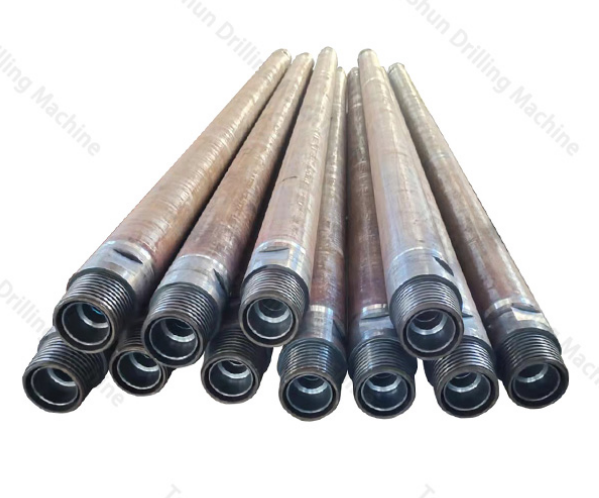What are the differences between an oil drill pipe and an oil casing pipe?
In the world of drilling operations, comprehending the nuances between various types of pipes, notably oil casing pipe and oil drill pipe, forms the cornerstone of technical expertise. Each serves a distinct purpose in the extraction of oil and gas, contributing uniquely to the efficiency and success of drilling operations. Gaining a foundational understanding of these pipes is crucial for individuals seeking profound knowledge in this domain.
Overview of Drill Pipe and Casing Pipe
Drill Pipe
Drill pipes constitute a fundamental component of the drilling process. Drill pipe connects the rig surface equipment with the bottom hole assembly and the bit, both to pump drilling fluid to the bit and to be able to raise, lower and rotate the bottom hole assembly and bit. Constructed from high-strength steel, these pipes come in various sizes, commonly ranging from 2 3/8 inches to 6 5/8 inches in diameter. They possess threaded connections at both ends to link multiple segments together, forming the drill string.
Casing Pipe
Contrarily, casing pipes serve a different role in drilling operations. These pipes are larger in diameter and are utilized to line the drilled hole, safeguarding the wellbore from collapsing and preventing contaminants from infiltrating the extracted oil or gas. Casing pipes also provide structural integrity to the well.
Differentiating Oil Casing Pipe from Oil Drill Pipe
Oil Casing pipes and oil drill pipes are common in squeezing cement and handling underground accident industries. Oil casing pipe refers to the steel pipe that supports well walls of gas and oil wells. A drill pipe is a hollow, steel or aluminum pipe normally used on drilling rings.
Drill pipes are essential for the drilling process. Drill pipes often turn the drill bit that cuts the rock. On the contrary, casing pipes refer to certain tubing that are set inside the well. It supports the well stream. Casing pipes withstand water from being contaminated through drilling mud.
Drill pipes and casing tubes adhere to distinct standards. The API standard specifies the 5D specification as the optimal choice for drill pipes, while the APT standard necessitates 5CT for casing pipes.
Casing pipes offer a limited selection of connection types compared to the ample options available for drilling pipes.
While drilling, there is a continuous risk of potential leaks in both upper and lower layers. Casing plays a crucial role in averting leaks from the upper layer during drilling operations, ensuring that while drilling into the lower layers, the upper layer remains sealed.
Various layers of casing are employed in wells based on drilling depth. Casing is commonly categorized into surface casing, intermediate casing, and production casing, tailored to specific drilling requirements.
Drill pipes are responsible for conveying drilling mud to the drill bit and must possess sufficient strength to endure intense internal and external pressures. These pipes come in various types like square drill rods and weighted drill rods.
The functions of oil casing pipes and oil drilling pipes are distinct. Oil casing pipes provide reinforcement to the well walls. The drill string comprises various components like the drill bit, drill rod, and stabilizer. It serves to elevate the drill bit, transfer power, and apply necessary weight during drilling operations. Finding a distributor specializing in used oilfield pipes is essential if your business requires them.
Material Composition and Construction
One of the primary distinctions between oil casing pipe and oil drill pipe lies in their material composition and construction. Drill pipes are designed to withstand high tensile loads and torque during drilling. They are often made from specialized alloy steel and are thinner compared to casing pipes. In contrast, casing pipes are thicker, constructed from steel alloys that exhibit enhanced resistance to corrosion and external pressures.
Functionality in Drilling Operations
Drill pipes primarily facilitate the drilling process by transmitting drilling fluid, such as mud, to the drill bit. These pipes must withstand immense pressure and torque while allowing efficient transmission of power to the bit. On the other hand, casing pipes are employed for structural purposes, providing support to the wellbore and preventing it from caving in. They also create a secure barrier against groundwater contamination and isolate different geological formations.
Conclusion: Enhancing Efficiency in Oil Drilling
In conclusion, understanding the distinction between oil casing pipes and oil drill pipes is imperative for effective drilling operations. Both play crucial roles, with casing pipes ensuring well integrity and drill pipes facilitating the drilling process itself.
For premium-quality pipes tailored to your oil drilling needs, don't hesitate to contact us. Our expertise and comprehensive range of products will elevate the efficiency and success of your drilling operations.

评论
发表评论